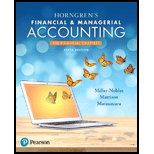
Concept explainers
Assets are listed on the
a. purchase date.
b. adjustments.
c. liquidity.
d. balance.
Balance sheet: This financial statement reports a company’s resources (assets) and claims of creditors (liabilities) and stockholders (stockholders’ equity) over those resources, on a specific date. The resources of the company are assets which include money contributed by stockholders and creditors. Hence, the main elements of the balance sheet are assets, liabilities, and stockholders’ equity.
To identify: The basis of order of listing assets on the balance sheet.
Answer to Problem 1QC
Explanation of Solution
Explanation for correct answer: The assets and liabilities of the balance sheet are listed based on the order of liquidity. The order of liquidity states that list of assets and liabilities that are quickly and easily available to convert into immediate cash are listed first and so on. In order of liquidity, the assets are listed as current assets, fixed assets, and intangible assets. However, the liabilities are listed as current liabilities and long-term liabilities.
Explanation for incorrect answers:
- Option (a) is incorrect because the format of the balance sheet does not contain date column. The balance sheet only shows the items of assets, liabilities, and equity along with their amount.
- Option (b) is incorrect because the balance sheet records the accounts balances of those assets and liabilities which are already adjusted and transferred to the adjusted trial balance.
- Option (d) is incorrect because the assets and liabilities on the balance sheet are listed in order of their nature of occurrences. But, they not listed in order of their balance.
Want to see more full solutions like this?
Chapter 4 Solutions
Horngren's Financial & Managerial Accounting, The Financial Chapters (6th Edition)
 Cornerstones of Financial AccountingAccountingISBN:9781337690881Author:Jay Rich, Jeff JonesPublisher:Cengage Learning
Cornerstones of Financial AccountingAccountingISBN:9781337690881Author:Jay Rich, Jeff JonesPublisher:Cengage Learning College Accounting (Book Only): A Career ApproachAccountingISBN:9781337280570Author:Scott, Cathy J.Publisher:South-Western College Pub
College Accounting (Book Only): A Career ApproachAccountingISBN:9781337280570Author:Scott, Cathy J.Publisher:South-Western College Pub College Accounting, Chapters 1-27AccountingISBN:9781337794756Author:HEINTZ, James A.Publisher:Cengage Learning,
College Accounting, Chapters 1-27AccountingISBN:9781337794756Author:HEINTZ, James A.Publisher:Cengage Learning,



